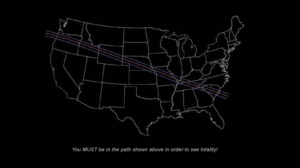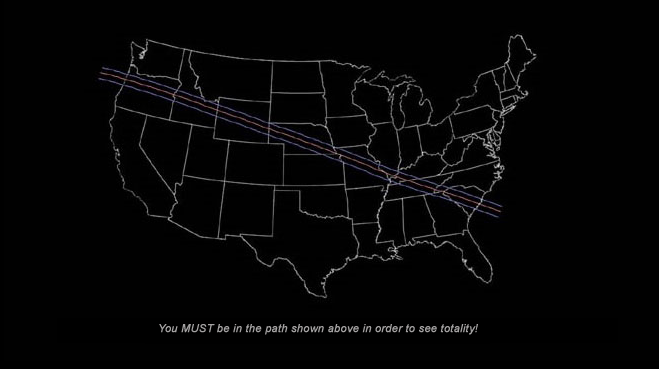
Photo courtesy of eclipse2017.org
The continental eclipse is the first since 1918, above is the path of totality.
(WARRENSBURG, Mo.) – The Warrensburg community is one of many in the United States that are directly in the path of the first total solar eclipse since 1918 to trek from one coast to the other in the U.S.
The celestial event will take place Monday, Aug. 21. The eclipse will start at 11:43 a.m. in Warrensburg and will reach its peak at 1:11 p.m. The sun will be completely exposed again at 4:38 p.m., according to eclipse2017.org.
The path of totality averages approximately 70 miles wide and extends from Oregon to Georgia. This will give people in limited areas across the continental U.S. a combined total of about 90 minutes to witness what happens when the Earth, moon and sun perfectly align. The last solar eclipse occurred a year ago in Indonesia.
The next continental solar eclipse will be in 2024 and will extended from southeast Canada to northwest Mexico.
Depending on where people are located in the coverage pathway, Warrensburg community members who venture outside will witness a gradual blocking out of the sun to a maximum of about 99.8 percent, according to UCM assistant professor of physics Mike Foster, and a participant in the National Solar Observatory’s citizen-based Continental America Telescopic Eclipse Experiment.
This will occur as the new moon moves between the sun and the Earth at the perfect distance to obstruct the sunlight. The duration for optimal viewing will be short – just minutes – and will vary even within the local area.
Because the large metropolitan areas of Kansas City and St. Louis are located on the path as it angles across Missouri, the state is uniquely positioned as one of the most highly populated areas to have an opportunity to view the eclipse.
“It’s going to gradually get darker and darker,” Foster said in a news release. “For example, when you walk under trees, the leaves in the trees will act like a pinhole camera. Instead of the shadows in those leaves looking normal, they will have little crescent shapes of the spots of sun coming out, and it will be darker than usual.”
He noted that efforts also are underway to provide viewing opportunities on the UCM campus utilizing broadband, full-spectrum telescopes and telescopes that can allow individuals to look at hydrogen emissions during the eclipse. Such activities are still being finalized. Foster said individuals who plan to attend this event or view on their own need to protect their eyes from harmful sun rays.
“Looking at the sun, you expose your eyes to a lot of ultraviolet and infrared (radiation), and of course the eye can’t detect any of those,” Foster said. “So, there are things you can do about it. You can make a pinhole shadowbox that will allow you to project the sun onto something that you can look at and see its shape. That is completely safe.”
He discourages people from using tools like welding masks and goggles for viewing because most do not keep out the harmful radiation that can harm their eyes. Foster said many of these safety tips are available at eclipse2017.nso.edu/citizencate.
“We’d like to give as many people an opportunity to see the eclipse as we can, but we feel a responsibility to make sure that it be done safely, and we want to make sure they know which way to do it before the event,” Foster said.
For more information, visit eclipse2017.nso.edu/citizencate.



Leave a Reply